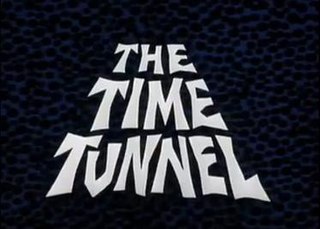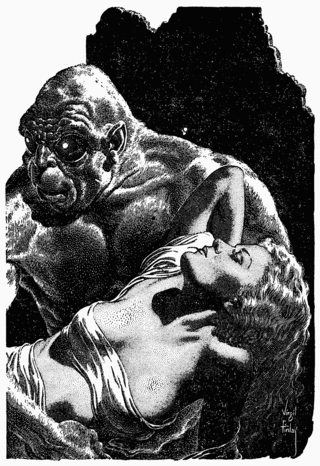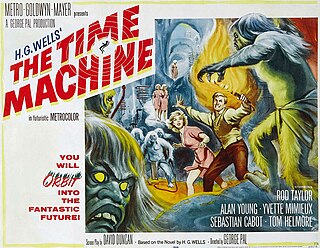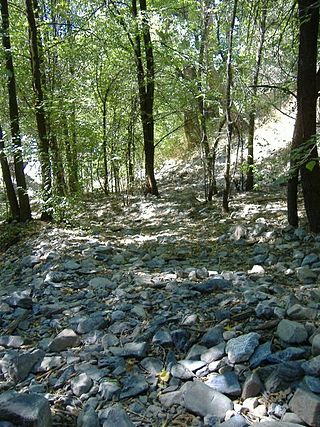
The Time Machine is a post-apocalyptic science fiction novella by H. G. Wells, published in 1895. The work is generally credited with the popularization of the concept of time travel by using a vehicle or device to travel purposely and selectively forward or backward through time. The term "time machine", coined by Wells, is now almost universally used to refer to such a vehicle or device.

The Time Tunnel is an American color science fiction TV series written around a theme of time travel adventure starring James Darren and Robert Colbert. The show was creator-producer Irwin Allen's third science-fiction television series and was released by 20th Century Fox Television and broadcast on ABC. The show ran for one season of 30 episodes from 1966 to 1967.

The Eloi are one of the two fictional post-human races, along with the Morlocks, in H. G. Wells' 1895 novel The Time Machine.

The Time Ships is a 1995 hard science fiction novel by Stephen Baxter. A canonical sequel to the 1895 novella The Time Machine by H. G. Wells, it was officially authorized by the Wells estate to mark the centenary of the original's publication. The Time Ships won critical acclaim. It won the John W. Campbell Memorial Award and the Philip K. Dick Award in 1996, as well as the British Science Fiction Association Award in 1995. It was also nominated for the Hugo, Clarke and Locus Awards in 1996.

Morlocks are a fictional species created by H. G. Wells for his 1895 novel The Time Machine. They are the story's main antagonists. Since their creation by H. G. Wells, the Morlocks have appeared in many other works such as sequels, films, television shows, and works by other authors, many of which have deviated from the original description.

Sundance Resort, also known as Sundance Mountain Resort, is a ski resort located 13 miles (21 km) northeast of Provo, Utah. It includes more than 5,000 acres (2,000 ha) on the slopes of Mount Timpanogos in Utah's Wasatch Range. Alpine skiing began on the site in 1944. Actor Robert Redford acquired the area in 1968, and established a year-round resort that would later spawn the independent Sundance Film Festival and the non-profit Sundance Institute. The resort was first listed as a census-designated place (CDP) before the 2020 census.
Antonga, or Black Hawk, was a nineteenth-century war chief of the Timpanogos Tribe in what is the present-day state of Utah. He led the Timpanogos against Mormon settlers and gained alliances with Paiute and Navajo bands in the territory against them during what became known as the Black Hawk War in Utah (1865–1872). Although Black Hawk made peace in 1867, other bands continued raiding until the US intervened with about 200 troops in 1872. Black Hawk died in 1870 from a gunshot wound he received while trying to rescue a fallen warrior, White Horse, at Gravely Ford Richfield, Utah, June 10, 1866. The wound never healed and complications set in.

I Was a Teenage Werewolf is a 1957 American science fiction horror film directed by Gene Fowler Jr., and starring Michael Landon as a troubled teenager, Yvonne Lime and Whit Bissell. Co-written and produced by cult film producer Herman Cohen, it was one of the most successful films released by American International Pictures (AIP).

Whitner Nutting Bissell was an American character actor.
Social science fiction is a subgenre of science fiction, usually soft science fiction, concerned less with technology/space opera and more with speculation about society. In other words, it "absorbs and discusses anthropology" and speculates about human behavior and interactions.
Chief Walkara was a Shoshone leader of the Utah Indians known as the Timpanogo and Sanpete Band. It is not completely clear what cultural group the Utah or Timpanogo Indians belonged to, but they are listed as Shoshone. He had a reputation as a diplomat, horseman and warrior, and a military leader of raiding parties, and in the Wakara War.

The Time Machine is a 1960 American period post-apocalyptic science fiction film based on the 1895 novella of the same name by H. G. Wells. It was produced and directed by George Pal, and stars Rod Taylor, Yvette Mimieux, and Alan Young. The story is set in Victorian England and follows an inventor who constructs a machine that enables him to travel into the distant future. Once there, he discovers that mankind's descendants have divided into two species, the passive, childlike, and vegetarian Eloi and the underground-dwelling Morlocks, who feed on the Eloi.

The Time Machine is a 2002 American post-apocalyptic science fiction film loosely adapted by John Logan from the 1895 novel of the same name by H. G. Wells and the screenplay of the 1960 film of the same name by David Duncan. Arnold Leibovit served as executive producer and Simon Wells, the great-grandson of the original author, served as director. The film stars Guy Pearce, Orlando Jones, Samantha Mumba, Mark Addy, and Jeremy Irons, and includes a cameo by Alan Young, who also appeared in the 1960 film adaptation. The film is set in New York City instead of London, and contains new story elements not present in the original novel nor the 1960 film adaptation, including a romantic subplot, a new scenario about how civilization was destroyed, and several new characters such as an artificially intelligent hologram and a Morlock leader.
David John Lake was an Indian-born Australian science fiction writer, poet, and literary critic. He wrote as David Lake and David J. Lake.
Time Machine: The Journey Back is a combination documentary short-sequel to George Pal's 1960 film The Time Machine, hosted by Time Machine star Rod Taylor and produced and directed by Clyde Lucas. The film was produced in 1993 for airing on PBS stations.

The Battle Creek massacre was a lynching of a Timpanogos group on March 5, 1849, by a group of 35 Mormon settlers at Battle Creek Canyon near present-day Pleasant Grove, Utah. It was the first violent engagement between the settlers who had begun coming to the area two years before, and was in response to reported cattle theft by the group. The attacked group was outnumbered, outgunned, and had little defense against the militia that crept in and surrounded their camp before dawn. The massacre had been ordered by Brigham Young, the Utah territory governor and president of the Church of Jesus Christ of Latter-day Saints (LDS)Mormon settlement of Utah Valley soon followed the attack at Battle Creek. One of the young survivors from the group of 17 children, women, and men who had been attacked grew up to be Antonga Black Hawk, a Timpanogos leader in the Black Hawk War.

Eugene Lusk "Timpanogos" Roberts (1880–1953) was head of the department of physical education and a coach of sports including track and field at Brigham Young University starting in 1910.
Weena is a fictional character in the novel The Time Machine, written by H. G. Wells in 1895 on the concept of time travel. In the story, an unnamed time traveler travels to 802,701 A.D. using his time machine, to find that humans have evolved into two species: the Eloi, the leisure class; and the Morlocks, the working class. He meets an Eloi girl named Weena, whom he takes on an expedition and loses in his battle against the Morlocks.
The Battle at Fort Utah was a violent attack in 1850 in which 90 Mormon militiamen surrounded an encampment of Timpanogos families on the Provo River one winter morning, and laid siege for two days, eventually shooting between 40 and 100 Native American men and one woman with guns and a cannon during the attack as well as during the pursuit and capture of the two groups that fled the last night. One militiaman died from return fire during the siege. Of the Timpanogos people who fled in the night, one group escaped southward, and the other ran east to Rock Canyon. Both groups were captured, however, and the men were executed. Over 40 Timpanogos children, women, and a few men were taken as prisoners to nearby Fort Utah. They were later taken northward to the Salt Lake Valley and sold as slaves to church members there. The bodies of up to 50 Timpanogos men were beheaded by some of the settlers and their heads put on display at the fort as a warning to the mostly women and children prisoners inside.

The Terminator is a 1992 video game published for several Sega consoles, including the Sega Genesis, the Master System, and the portable Game Gear. It is based on the 1984 film of the same name. The game was developed by Probe Software and published by Virgin Games. The Terminator was praised for its graphics and sound, but criticized for its gameplay.












